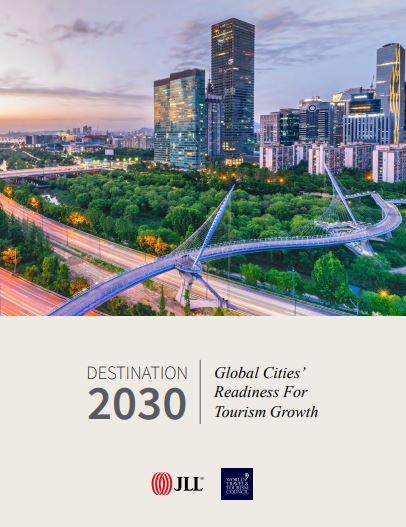
June 2019
Destination 2030: Global Cities’ Readiness for Tourism Growth
WTTC and JLL have teamed up to launch the first assessment of cities’ readiness for tourism growth, through the development of a unique methodology to evaluate and deliver on solutions to foster sustainable growth in tourism activity.
Destination 2030 is a comprehensive index based on the evaluation of more than 75 indicators in 50 global markets, and it addresses the question of what makes a city ready for Travel & Tourism growth.
This research takes an approach of assessing ‘readiness’, through which it aims to help city governments and tourism bodies better understand how well cities are positioned for future growth, while identifying gaps and opportunities that should be considered in future tourism strategy planning. The newly-created index brings together a broad spectrum of destination practices and community attributes to determine a level and type of readiness. The levels range from emerging to established market tourism hubs with varying levels of infrastructure.
Five city typologies were defined on the basis of the level of readiness:
- Dawning Developers: Cities have an emerging tourism infrastructure, gradual tourism growth and lower visitor concentration but with potential to grow; such as Manila, Moscow and Riyadh.
- Emerging Performers: Cities have an emerging tourism infrastructure, growing tourism momentum and the start of increasing pressures related to tourism growth; including Delhi, Istanbul and Mexico City.
- Balanced Dynamics: Cities are often financial hubs with a lower share of leisure compared to business travel, but they also have an established tourism infrastructure and potential for Travel & Tourism growth. Examples include Chicago, Munich and Tokyo.
- Mature Performers: Cities have strong leisure and/or business travel dynamics and an established tourism infrastructure, but there is a risk of future strains related to visitor volume, infrastructure or activity that is testing readiness for additional growth. Such cities include New York, Berlin, London and Sydney.
- Managing Momentum: Cities have high growth momentum driven by leisure travel and an established tourism infrastructure. Yet, these cities face pressures to ensure that the volume of travellers is matched with the required urban infrastructure and tourism product diversity. Examples include Amsterdam, Barcelona and Prague.
Our hope is that this work helps enable effective decision-making which supports thriving city destinations and provides actionable investment solutions that foster sustainable growth in future tourism activity.
